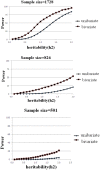Bivariate genome-wide association analyses identified genes with pleiotropic effects for femoral neck bone geometry and age at menarche
- PMID: 23593202
- PMCID: PMC3617200
- DOI: 10.1371/journal.pone.0060362
Bivariate genome-wide association analyses identified genes with pleiotropic effects for femoral neck bone geometry and age at menarche
Abstract
Femoral neck geometric parameters (FNGPs), which include cortical thickness (CT), periosteal diameter (W), buckling ratio (BR), cross-sectional area (CSA), and section modulus (Z), contribute to bone strength and may predict hip fracture risk. Age at menarche (AAM) is an important risk factor for osteoporosis and bone fractures in women. Some FNGPs are genetically correlated with AAM. In this study, we performed a bivariate genome-wide association study (GWAS) to identify new candidate genes responsible for both FNGPs and AAM. In the discovery stage, we tested 760,794 SNPs in 1,728 unrelated Caucasian subject, followed by replication analyses in independent samples of US Caucasians (with 501 subjects) and Chinese (with 826 subjects). We found six SNPs that were associated with FNGPs and AAM. These SNPs are located in three genes (i.e. NRCAM, IDS and LOC148145), suggesting these three genes may co-regulate FNGPs and AAM. Our findings may help improve the understanding of genetic architecture and pathophysiological mechanisms underlying both osteoporosis and AAM.
Conflict of interest statement
Figures



Similar articles
-
Bivariate genome-wide association analyses of femoral neck bone geometry and appendicular lean mass.PLoS One. 2011;6(11):e27325. doi: 10.1371/journal.pone.0027325. Epub 2011 Nov 7. PLoS One. 2011. PMID: 22087292 Free PMC article.
-
Bivariate Genome-Wide Association Study Implicates ATP6V1G1 as a Novel Pleiotropic Locus Underlying Osteoporosis and Age at Menarche.J Clin Endocrinol Metab. 2015 Nov;100(11):E1457-66. doi: 10.1210/jc.2015-2095. Epub 2015 Aug 27. J Clin Endocrinol Metab. 2015. PMID: 26312577 Free PMC article.
-
The differences of femoral neck geometric parameters: effects of age, gender and race.Osteoporos Int. 2010 Jul;21(7):1205-14. doi: 10.1007/s00198-009-1057-0. Epub 2009 Oct 3. Osteoporos Int. 2010. PMID: 19802512 Free PMC article.
-
Comparison of femoral neck geometric parameters between Chinese and Japanese females.Zhong Nan Da Xue Xue Bao Yi Xue Ban. 2022 Mar 28;47(3):319-327. doi: 10.11817/j.issn.1672-7347.2022.210456. Zhong Nan Da Xue Xue Bao Yi Xue Ban. 2022. PMID: 35545324 Free PMC article. Chinese, English.
-
Gender differences in a reference database of age-related femoral neck geometric parameters for Chinese population and their association with femoral neck fractures.Bone. 2016 Dec;93:64-70. doi: 10.1016/j.bone.2016.09.014. Epub 2016 Sep 15. Bone. 2016. PMID: 27641474
Cited by
-
Bivariate genome-wide association study (GWAS) of body mass index and blood pressure phenotypes in northern Chinese twins.PLoS One. 2021 Feb 4;16(2):e0246436. doi: 10.1371/journal.pone.0246436. eCollection 2021. PLoS One. 2021. PMID: 33539483 Free PMC article.
-
Genetics of Obesity Traits: A Bivariate Genome-Wide Association Analysis.Front Genet. 2018 May 16;9:179. doi: 10.3389/fgene.2018.00179. eCollection 2018. Front Genet. 2018. PMID: 29868124 Free PMC article.
-
Endocrine crosstalk between muscle and bone.Curr Osteoporos Rep. 2014 Jun;12(2):135-41. doi: 10.1007/s11914-014-0209-0. Curr Osteoporos Rep. 2014. PMID: 24667990 Free PMC article. Review.
-
Value of rare low bone mass diseases for osteoporosis genetics.Bonekey Rep. 2016 Jan 6;5:773. doi: 10.1038/bonekey.2015.143. eCollection 2016. Bonekey Rep. 2016. PMID: 26793304 Free PMC article. Review.
-
Differential effects of altered patterns of movement and strain on joint cell behaviour and skeletal morphogenesis.Osteoarthritis Cartilage. 2016 Nov;24(11):1940-1950. doi: 10.1016/j.joca.2016.06.015. Epub 2016 Jun 29. Osteoarthritis Cartilage. 2016. PMID: 27374878 Free PMC article.
References
-
- Kannus P, Parkkari J, Sievanen H, Heinonen A, Vuori I (1996) et?al (1996) Epidemiology of hip fractures. Bone 18: 57S–63S. - PubMed
-
- Turner CH, Hsieh YF, Muller R, Bouxsein ML, Baylink DJ, et al. (2000) Genetic regulation of cortical and trabecular bone strength and microstructure in inbred strains of mice. J Bone Miner Res 15 (6): 1126–1131. - PubMed
-
- Melton LJ, Beck TJ, Amin S, Khosla S, Achenbach SJ (2005) et?al (2005) Contributions of bone density and structure to fracture risk assessment in men and women. Osteoporos Int 16 (5): 460–467. - PubMed
-
- Shen H, Long JR, Xiong DH, Liu YJ, Liu YZ, et al. (2005) Mapping quantitative trait loci for cross-sectional geometry at the femoral neck. J Bone Miner Res 20 (11): 1973–1982. - PubMed
Publication types
MeSH terms
Grants and funding
LinkOut - more resources
Full Text Sources
Other Literature Sources

